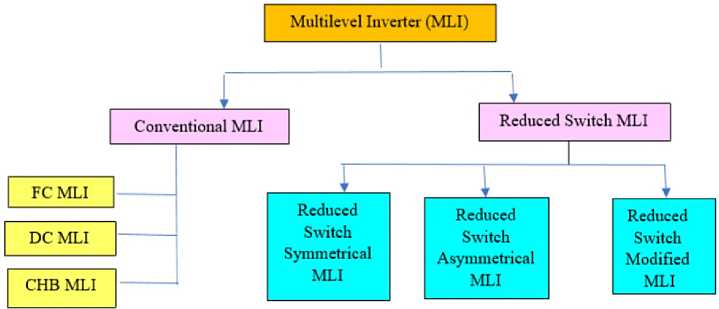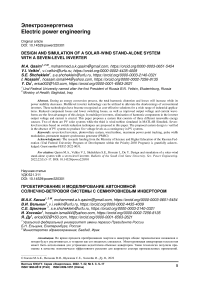Design and simulation of a solar-wind stand-alone system with a seven-level inverter
Автор: Qasim M.A., Velkin V.I., Shcheklein S.E., Hossain I., Du Y.
Журнал: Вестник Южно-Уральского государственного университета. Серия: Энергетика @vestnik-susu-power
Рубрика: Электроэнергетика
Статья в выпуске: 3 т.22, 2022 года.
Бесплатный доступ
During an energy conversion process, the total harmonic distortion and losses will increase while its power stability decreases. Multilevel inverter technology can be utilized to alleviate the shortcomings of conventional inverters. These technologies have become recognized as cost-effective solutions for a wide range of industrial applications. Reduced component losses and lower switching losses, as well as improved output voltage and current waveforms are the first advantages of this design. In multilayer inverters, elimination of harmonic components in the inverter output voltage and current is crucial. This paper proposes a system that consists of three different renewable energy sources. Two of them are PV solar systems while the third is wind turbine simulated in MATLAB Simulink. Seven-level inverters based on switch reduction techniques are proposed in this paper. The proposed system design is verified in the absence of PV systems to produce five voltage levels as a contingency in PV systems.
Seven-level inverters, photovoltaic system, wind turbine, maximum power point tracking, pulse width modulation, permanent magnet synchronous generator (pmsg)
Короткий адрес: https://sciup.org/147238631
IDR: 147238631 | УДК: 621.311 | DOI: 10.14529/power220301
Текст научной статьи Design and simulation of a solar-wind stand-alone system with a seven-level inverter
Renewable energy sources (RES) have become very important in recent years owing to their nondegradability, eco-friendliness and self-sufficiency. Systems using RES are reliable and can replace conventional generation techniques. Fossil fuels are degradable, non-renewable and contribute to climate change and ecological imbalance. Solar, wind and geothermal energies, as well as other renewable energy resources, are forms of RES. Solar and wind energy are the most commonly used RES [1]. The benefits of a solar photovoltaic systems over wind turbines include their minimal maintenance, lack of moving parts and ease of installation. Wind-turbine systems are less expensive than solar panels, especially when used in large quantities. However, they require a professional staff for operation and maintenance. The two technologies are typically combined using multiple RES so that they may deliver continuous power under various situations [2].
Since the amount of energy provided by renewable systems changes throughout the day, it is critical to maximize the delivered energy [3]. The output power of wind turbines and photovoltaic arrays is influenced by wind speed and solar irradiation. As a result, changes in these parameters must be handled appropriately by system control mechanisms. With variable wind, the turbine speed must be adjusted to optimize the generation of power to ensure that the system runs at its maximum power point (MPP). Similarly, the DC voltage and current at the output of the PV system must be modified to run the PV systems at their MPP [4]. The biggest issue that some RES encounter is they produce DC electrical energy. This requires equipment to convert DC to AC power. Inverters serve this role. However, there are switching components utilized during power conversion that reduce the stability and quality of the electricity [5].
Multilevel Inverter (MLI) technology is used at the DC output terminals of RES to convert the generated electricity into AC power and improve the power quality and stability. The benefits of MLI include improved voltage and current output waveforms, less electro-magnetic interference (EMI), their small size, and lower total harmonic distortion (THD) [6]. MLI switches are used to interrupt the DC so that it is produced at different levels. They are essential because they determine circuit size, installation dependability, control complexity and cost. In conventional MLIs, the size, cost and complexity of inverters increase with the output voltage level [7]. In this research, MLI switch reduction is used to provide a larger number of output levels with fewer switching components, thereby lowering costs. The proposed MLI circuit reduces the voltage stress on the switches, enhancing protection against overvoltage [8].
There are three main types of reduced switch MLIs that can be used. The first is a reduced switch symmetrical MLI (RSS-MLI) that produce many DC levels with equal magnitude. This method is a lower cost option. A reduced switch symmetrical MLI (RSA-MLI) produces DC of different magnitudes. Typically, this technology is used in a cascaded H-bridge method. Finally, a reduced switch modified MLI (RSM-MLI) does not use a cascaded H-bridge configuration. It cannot be used for high power applications due to its excessive voltage stress on H-bridge switches [9]. Fig. 1 shows the conventional and reduced switch MLIs.
Design and implementation of a single-phase switching reduction MLI in a stand-alone system fed from multiple individual RES are presented in this work. A new logical switching method, pulse width modulation (PWM), is used to create a seven-level output voltage. In this research, two PV-solar systems and one wind-turbine generator with a permanent magnet synchronous generator (PMSG) are offered as distinct energy sources. The proposed method is used to reduce the number of switching devices, thereby decreasing losses and THD.
The MATLAB Simulink program is used to simulate a seven-level inverter for use with renewable

Fig. 1. Conventional and reduced switch MLIs [9]
energies. RES continue to be more dominant in local power production for stand-alone networks than fossil fuel units. In this research, PV and wind turbine technologies are used to create a self-contained system with high reliability and security that can work under a variety of operational conditions. The contingency of reduced PV solar system performance (due to cloudy winter days, nighttime or fault event) is taken into consideration in this work. Multilevel inverters are an ideal way to employ inverters for stand-alone use in systems that produce just a few kilowatts.
Список литературы Design and simulation of a solar-wind stand-alone system with a seven-level inverter
- Ganesh D., Chandra Sekhar G. Simulation of Three Phase Nine-level Inverter for Interfacing with Solar PV system. International Journal of Innovative Research in Science, Engineering and Technology. 2017;6(8). DOI: 10.15680/IJIRSET.2016.0608165
- Hemeida A.M., El-Ahmar M.H., El-Sayed A.M., Hasanien H.M., Alkhalaf S., Esmail M.F.C., Senjyu T. Optimum design of hybrid wind/PV energy system for remote area. Ain Shams Engineering Journal. 2019. DOI: 10.1016/j.asej.2019.08.005
- Yasmeen S., Reddy P.R., Suraya S. Multilevel Inverter Based Hybrid Wind Solar Energy Conversion System for Power Quality Improvement. Journal of Resource - Management and Technology. 2020.
- Wandhare R.G., Agarwal V. Novel Integration of PV-Wind Energy System with Enhanced Efficiency. IEEE Transactions on Power Electronics. 2013. DOI: 10.1109/TPEL.2014.2345766
- Sami M., Mallick M.A. Cascaded H-Bridge 11-level Multilevel Inverter. International Journal of Engineering Research & Technology (IJERT). 2021;10(06):223-226.
- Balapriyan P., Veeraragavan K. Design and analysis of a 7-level inverter at different modulation indices with a closed loop control. International Journal of Pure and Applied Mathematics. 2018;119(14):637-642.
- Balakrishnan A.T., James A., Job J.T., Thomas A. Seven Level Inverter. International Journal of Engineering Research & Technology (IJERT). 2017;6(04):857-876. DOI: 10.17577/IJERTV6IS040653
- Gopal Y., Birla D., Lalwani M. Reduced switches multilevel inverter integration with boost converters in photovoltaic system. Applied Sciences. 2020. DOI: 10.1007/s42452-019-1848-7
- Gajulaa U., Devib M.K., Reddy N.M. Reduced Switch Multilevel Inverter Topologies and Modulation Techniques for Renewable Energy Applications. Turkish Journal of Computer and Mathematics Education. 2021;12(3):4659-4670. DOI: 10.17762/turcomat.v12i3.1879
- Sharma C.S., Tamrakar R. Design and simulation analysis of seven level cascaded grid connected multilevel inverter for SPV system. IJSDR. 2016;1(8):2455-2631.
- Arya L., Maheshwari K., Shakya J.S. A seven level asymmetric cascaded multilevel inverter design for an induction motor. IJRTI. 2016;1(3):2456-3315.
- Murugesan S., Senthilkumar R. Design of single phase seven level PV inverter using FPGA. International Journal of Emerging Technology in Computer Science & Electronics (IJETCSE). 2016;20(2):207-212.
- Salodkar P.A., Kulkarni P.S., Waghmare M.A., Chaturvedi P.C., Sandeep N. Asymmetric H-Bridge SinglePhase Seven-Level Inverter Topology with Proportional Resonant Controller. IETE Journal of Research. 2017. DOI: 10.1080/03772063.2017.1396934
- Kumaresan R., Gnanamba I. Seven level inverter with single DC source interconnected photovoltaic system. Int. J. Elec & Electr. Eng & Telecoms. 2016;5(2):1-15.
- Utomo W.M., Abu Bakar A., Alias S., Yi S.S., Setiawan M.I., Mudjanarko S.W., Sukoco A., Buswig Y.M., Taufik T. Modeling of a Single Phase 7-Level Cascaded H-Bridge Multilevel Inverter. International Journal of Engineering & Technology. 2018;7(2.6):327-330. DOI: 10.14419/ijet.v7i2.6.11704
- Singh A., Jain M., Singh S. Analysis of THD and Output Voltage for Seven Level Asymmetrical Cascaded H-Bridge Multilevel Inverter using LSCPWM Technique. International Journal of Computer Applications. 2015;112(1):1-6.
- Gole R., Lakshminarayana C. Seven level modular multilevel converter with FFT analysis. International Journal of Engineering Applied Sciences and Technology. 2020;5(3):553-558.
- Bhanutej J.N., Naidu R.C. A 7-level inverter with less number of switches for grid-tied PV applications. International Journal of Advanced Technology and Engineering Exploration. 2021;8(78):631-642. DOI: 10.19101/IJATEE.2021.874090
- Jadhav R.S., Patil S.B. Design and implementation of PV-wind battery hybrid system for off-grid and on-grid. In: Proceedings of the Fourth International Conference on Inventive Systems and Control, ICISC; 2020. P. 612-618. DOI: 10.1109/ICISC47916.2020.9171150
- Boopathy1 C.P., Kaliamoorthy M. A novel asymmetrical single-phase multilevel inverter suitable for hybrid renewable energy sources. Circuits and Systems. 2016;7(6):932-945. DOI: 10.4236/cs.2016.76079
- Udhayakumar P., Saravanan C., Lydia M. Stand-alone wind energy supply system using permanent magnet synchronous generator. International Journal of Innovative Technology and Exploring Engineering (IJITEE). 2013;2(3):130-135.
- Chen J-H., Yau H-T., Hungm W. Design and study on sliding mode extremum seeking control of the chaos embedded particle swarm optimization for maximum power point tracking in wind power systems. Energies. 2014;7:1706-1720. DOI: 10.3390/en7031706
- Austin J.M., Joseph J.S. Design and implementation of multilevel inverter for drive applications with minimum number of transistors. Journal of Chemical and Pharmaceutical Sciences. JCPS. 2016;9(1):378-382.
- Rajl K.M, Parthasarathy C.A., Dash S.S., Doss M.A.N. Performance comparison of seven level inverter and nine level inverter with minimum devices. International Science Press, IJCTA. 2016;9(15):7523-7536.
- Deekshith K., Dhruva A., Nagaraju H., Reddy B. Solar tracking system. International Journal of Scientific & Engineering Research. 2015;6(9):994-999.
- Mahanta P.K., Debnath K., Rahman M.H. Modeling and simulation of a PV module based power system using MATLAB/Simulink. Dhaka Univ. J. Sci. 2014;62(2):127-132. DOI: 10.3329/dujs.v62i2.21977
- Qasim M.A., Alwan N.T., PraveenKumar S., Velkin V.I., Agyekum E.B. A new maximum power point tracking technique for thermoelectric generator modules. MDPI Inventions. 2021;6(88):1-11. DOI: 10.3390/inventions6040088
- Qasim M.A, Velkin V.I. Maximum power point tracking techniques for micro-grid hybrid wind and solar energy systems - a review. International Journal on Energy Conversion (IRECON) Praise Worthy Prize. 2020;8(6):223-234. DOI: 10.15866/irecon.v8i6.19502
- Qasim M.A. PWM effect on MPPT for hybrid PV solar and wind turbine generating systems at various loading conditions. Periodicals of Engineering and Natural Sciences. 2021;9(2):581-592. DOI: 10.21533/pen.v9i2.1840


